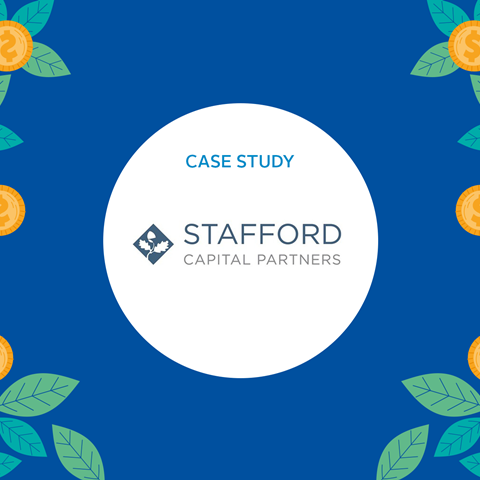Organisation details:
Name: Stafford Capital Partners Limited (as part of the Stafford Capital Partners Group)
Signatory type: Asset manager
HQ country: United Kingdom
AUM: USD$7.9 billion
Covered in this case study:
Asset class(es): Forestry (timberland)
Geography: Global
Stafford Capital Partners is an international private markets investment and advisory group with more than USD$7.9bn of funds under management. Stafford invests in several asset classes, including real assets, such as timberland. The Stafford timberland strategy offers scope for significant carbon removals and adheres to high standards of sustainability, including those for biodiversity.
Why we focus on biodiversity conservation and improvement
Forests are biologically diverse ecosystems that offer a wide variety of habitats for plants, animals and micro-organisms. Commercial forests – which generally rely on a single tree species – are often seen as monocultures that reduce overall biodiversity. However, properly managed, commercial forests can improve former agricultural wasteland and re-establish habitats.
Commercial forests are often established on sites that have been degraded through poor agricultural practices. Planting trees across the entirety of such land would result in a portion of trees growing on unsuitable sites, such as riparian zones, wetlands, or steep slopes. This can result in trees that are more susceptible to pests or disease. Instead, well-designed forests should set such areas aside for management as conservation zones (30-50% of the gross land area), resulting in a landscape containing a mosaic of open areas together with tree stands of different ages. Each conservation zone has its own Annual Plan of Operations, which details the relevant management activities depending on the type and condition of the ecosystem. Typical management activities include:
- control of invasive weeds
- control of insect or vertebrate pests
- fire protection (e.g. clearing and maintaining firebreaks)
- rehabilitation of natural vegetation (either by direct planting or assisted regeneration)
- maintaining adjacent forest roads (with a strong focus on drainage to limit erosion / siltation)
- monitoring and prevention of unauthorised access to the area (e.g., incursion by livestock, poaching)
These zones provide an improved range of habitats and, given that competing pressure from livestock is removed, there is more opportunity for native species to become re-established. It also results in a commercial forest that is healthier, more productive and more resilient than commercial forests that do not employ such practices.
Our attention to biodiversity conservation and improvement forms part of a broader investor focus on sustainability in the timberland sector. Institutional investors are increasingly seeking assurance that their investments are having a positive impact on nature and this is a common topic when we engage with new or existing investors.
This could be driven by a desire to pursue a broad impact strategy that includes a natural capital allocation; by plans to reach a particular climate target that involves nature-based solutions; or by a desire to prepare for increasing disclosure. We believe it is therefore critical that these requirements are satisfied if new capital is to be successfully attracted to the sector. Although many investors do not yet have clearly defined objectives on biodiversity, in our experience the topic increasingly features in DDQs and RFPs, as well as informal conversations. As such, we are committed to ensuring that our clients have a clear ability to demonstrate high standards and performance on sustainability and biodiversity to their beneficiaries and other stakeholders.
How we minimise biodiversity risks through forestry investments
Our timberland business currently offers investors two strategies:
1. Core Timberland Strategy: This approach involves investing in existing timberland and maintaining current biodiversity levels. The potential for making significant additional positive impacts is relatively limited.
2. Impact Strategy: This strategy focuses on afforestation (planting new forests) on degraded lands previously used for agricultural purposes, such as cattle ranching. Given that these lands start with a low biodiversity value, we believe that the strategy can present a significant opportunity to enhance biodiversity. Additionally, this approach aims to generate carbon offsets, which can contribute to carbon sequestration efforts.
For both strategies, we have developed a forestry investment process that involves rigorous screening, assessment and monitoring to ensure that investments are managed in a sustainable manner and to minimise biodiversity risks. The process follows four key components:
Exclusions
We have introduced strict criteria on the types of forests we will invest in. We will not invest in natural forests and instead focus only on planted forests and semi-natural managed forests. We take this approach as we believe natural forests should be a priority for conservation, they are rich in biodiversity and hold native vegetation. We focus on regions with strong governance and legal frameworks and will not invest in countries where forest industry and governance standards are poorly developed.
Frameworks
We are striving for 100% of our investments to hold certification under one or more of the major forestry certification standards, such as SFI, FSC or PEFC. Certification is backed by broad-based and detailed frameworks for assessing the management of biodiversity. This includes adherence to strict environmental and social criteria that encompass nature-related threats, such as the SFI Forest Management Standard’s performance measures and indicators. A number of our timber strategy funds are classified as Article 8 or Article 9 under the European Union’s Sustainable Finance Disclosure Regulation (SFDR), which helps us to be transparent about the sustainability criteria deployed for our investments. For the Article 9 fund, these include do-no-significant-harm criteria to ensure that forestry practices do not cause substantial negative impacts on the environment.
Engagement
We invest primarily through a select group of forestry managers which it knows well, and which have proven track records in sustainable forest management. After investment, Stafford will continue to engage with the fund manager via regular meetings structured around annual ESG surveys and ad hoc site visits to the underlying assets.
Assets auditing
Annual independent asset audits maintain the third-party forest certification, which serves as a key indicator that the assets are being managed sustainably. Stafford conducts a certification survey for our entire timberland portfolio every year, with the results published in our annual Sustainability Report.
Example: Stafford International Timberland IX
In 2022, Stafford International Timberland IX Fund invested in an asset called Tennessee Valley Forest (TVF) located in the southeastern US. The asset generates a stable investment return from wood sales, which involves harvesting a small portion of the forest each year. The asset passed Stafford’s screening during due diligence because it was:
- a planted forest
- in a country with developed regulations covering wildlife protection
- certified against the Sustainable Forest Initiative (SFI) by a third party
The certification process includes annual checks that biodiversity is being maintained. For example, occurrences of three categories of rare or very rare species globally or at a state level are identified using the Natural Heritage Database Program (which is updated every two years) and marked on operational planning maps. This data is crucial for making informed decisions about land use and management, ensuring negative impacts are minimised and opportunities for increasing rare species populations are identified. Special guidance is issued for the management of each site, which is inspected twice a year. Pleasingly, SFI auditors noted that these practices go above and beyond what the standard requires and what most other companies have done. For example, TVF identifies, marks and plans around the top three categories of state- and global-level rare species, while the standards require only two.
Further analysis indicated the asset has the potential to maintain a stable investment return from wood sales whilst also improving biodiversity levels. This has been achieved by planning and implementing harvesting and replanting operations in a way that mimics natural ecosystem processes. For example, regeneration in natural woodland occurs when a gap is created in the canopy allowing sunlight through, such as by a falling tree or when a natural event causes mortality in a larger number of trees. TVF replicates this process by harvesting a small proportion of the property each year across a number of individual sites, all of which are replanted, resulting in a diverse forest structure that offers a wider range of habitats for different species. This is further aided by leaving irregular shaped openings when harvesting, which further simulates natural events. These methods aim to support biodiversity.
Since the investment, the asset has been recertified and TVF is also aiming to incorporate monitoring and reporting recommendations put forward by the Taskforce on Nature-related Financial Disclosures, including tracking of specific metrics. For example, TVF plans to trial the use of environmental DNA in providing data that can be used to quantify species presence and abundance over time.












